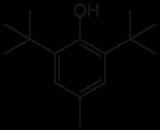Appearance White to yellow powder Molar mass 220.35 g/mol Boiling point 265 °C | Formula C15H24O Melting point 70 °C Density 1.05 g/cm³ | |
 | ||
Related compounds IUPAC ID 2,6-bis(1,1-dimethylethyl)-4-methylphenol | ||
Bht or butylated hydroxytoluene
Butylated hydroxytoluene (BHT), also known as dibutylhydroxytoluene, is a lipophilic organic compound, chemically a derivative of phenol, that is useful for its antioxidant properties. European and U.S. regulations allow small amounts to be used as a food additive. In addition to this use, BHT is widely used to prevent oxidation in fluids (e.g. fuel, oil) and other materials where free radicals must be controlled.
Contents
- Bht or butylated hydroxytoluene
- Occurrence
- Production
- Reactions
- Applications
- Food additive
- Antioxidant
- Health effects
- References
Occurrence
Phytoplankton, including the green algae Botryococcus braunii, as well as three different cyanobacteria (Cylindrospermopsis raciborskii, Microcystis aeruginosa and Oscillatoria sp.) are capable of producing BHT. Confirmation was made via gas chromatography–mass spectrometry analysis.
Production
Industrially, BHT is prepared by the reaction of p-cresol (4-methylphenol) with isobutylene (2-methylpropene) catalyzed by sulfuric acid:
CH3(C6H4)OH + 2 CH2=C(CH3)2 → ((CH3)3C)2CH3C6H2OHAlternatively, BHT is prepared from 2,6-di-tert-butylphenol by hydroxymethylation or aminomethylation followed by hydrogenolysis.
Reactions
The species behaves as a synthetic analog of vitamin E, primarily acting as a terminating agent that suppresses autoxidation, a process whereby unsaturated (usually) organic compounds are attacked by atmospheric oxygen. BHT stops this autocatalytic reaction by converting peroxy radicals to hydroperoxides. It effects this function by donating a hydrogen atom:
RO2. + ArOH → ROOH + ArO.RO2. + ArO. → nonradical productswhere R is alkyl or aryl, and where ArOH is BHT or related phenolic antioxidants. Each BHT consumes two peroxy radicals.
Applications
BHT is listed under three categories in catalogues and databases, such as food additive, household product ingredient, industrial additive, personal care product/cosmetic ingredient, pesticide ingredient, plastic/Rubber ingredient and Medical/Veterinary/Research
Food additive
BHT is primarily used as an antioxidant food additive. In the United States, it is classified as generally recognized as safe (GRAS) based on a National Cancer Institute study from 1979 in rats and mice. It is approved for use in the U.S. by the Food and Drug Administration: For example, 21 CFR § 137.350(a)(4) allows BHT up to 0.0033% by weight in "enriched rice", while 9 CFR § 381.147(f)(1) allows up to 0.01% in poultry "by fat content". It is permitted in the European Union under E321. It is forbidden as food additive in Japan (since 1958), Romania, Sweden, and Australia. Since the 1970s, BHT has been steadily replaced with butylated hydroxyanisole (BHA). Some food companies have voluntarily eliminated BHT from their products. Others like General Mills and Kellogg's announced in February 2015, following a petition by Vani Hari, that they were going to phase it out.
Antioxidant
BHT is also used as an antioxidant in products such as cosmetics, pharmaceuticals, rubber, electrical transformer oil (at 0.35%), and embalming fluid. In the petroleum industry, where BHT is known as the fuel additive AO-29, it is used in hydraulic fluids, turbine and gear oils, and jet fuels. BHT is also used to prevent peroxide formation in diethyl ether and other laboratory chemicals.
Some additive products contain BHT as their primary ingredient, while others contain the chemical merely as a component of their formulation, sometimes alongside butylated hydroxyanisole (BHA).
Health effects
Debate surrounds the link of BHT to cancer risk, asthma, and behavioral issues in children; some studies show a potential to increase and some showing a decreased risk. There is in vitro indication for endocrine disruption with effect on the testes and thyroid. Because of this uncertainty, the consumer group Center for Science in the Public Interest recommend to avoid BHT and puts BHT in its "caution" column. The National Cancer Institute determined in 1979 that it was noncarcinogenic in a mouse model.
BHT is marketed as a health food supplement in capsule form. It has been reported to have anti-viral effects, particularly in use against herpes family viruses, sometimes in combination with L-lysine and vitamin C. This latter use has made it into some of the more popular literature.
Closely related phenol antioxidants exhibit low toxicity. For example, the LD50 of 2,6-di-tert-butylphenol is greater than 9 g/kg.
